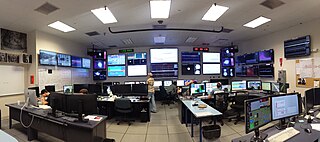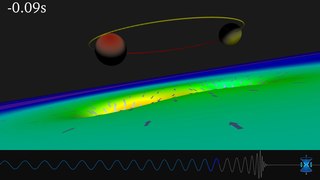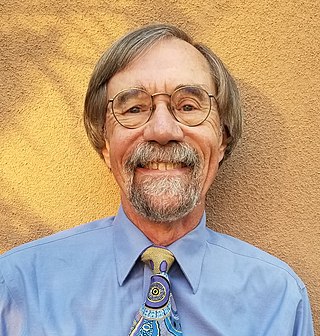Related Research Articles

The Laser Interferometer Gravitational-Wave Observatory (LIGO) is a large-scale physics experiment and observatory designed to detect cosmic gravitational waves and to develop gravitational-wave observations as an astronomical tool. Two large observatories were built in the United States with the aim of detecting gravitational waves by laser interferometry. These observatories use mirrors spaced four kilometers apart which are capable of detecting a change of less than one ten-thousandth the charge diameter of a proton.

Rainer "Rai" Weiss is an American physicist, known for his contributions in gravitational physics and astrophysics. He is a professor of physics emeritus at MIT and an adjunct professor at LSU. He is best known for inventing the laser interferometric technique which is the basic operation of LIGO. He was Chair of the COBE Science Working Group.

The Laser Interferometer Space Antenna (LISA) is a proposed space probe to detect and accurately measure gravitational waves—tiny ripples in the fabric of spacetime—from astronomical sources. LISA would be the first dedicated space-based gravitational wave detector. It aims to measure gravitational waves directly by using laser interferometry. The LISA concept has a constellation of three spacecraft arranged in an equilateral triangle with sides 2.5 million kilometres long, flying along an Earth-like heliocentric orbit. The distance between the satellites is precisely monitored to detect a passing gravitational wave.

GEO600 is a gravitational wave detector located near Sarstedt, a town 20 km to the south of Hanover, Germany. It is designed and operated by scientists from the Max Planck Institute for Gravitational Physics, Max Planck Institute of Quantum Optics and the Leibniz Universität Hannover, along with University of Glasgow, University of Birmingham and Cardiff University in the United Kingdom, and is funded by the Max Planck Society and the Science and Technology Facilities Council (STFC). GEO600 is capable of detecting gravitational waves in the frequency range 50 Hz to 1.5 kHz, and is part of a worldwide network of gravitational wave detectors. This instrument, and its sister interferometric detectors, when operational, are some of the most sensitive gravitational wave detectors ever designed. They are designed to detect relative changes in distance of the order of 10−21, about the size of a single atom compared to the distance from the Sun to the Earth. Construction on the project began in 1995.

The Virgo interferometer is a large interferometer designed to detect gravitational waves predicted by the general theory of relativity. Virgo is a Michelson interferometer that is isolated from external disturbances: its mirrors and instrumentation are suspended and its laser beam operates in a vacuum. The instrument's two arms are three kilometres long and located in Santo Stefano a Macerata, near the city of Pisa, Italy.

Gravitational waves are waves of the intensity of gravity generated by the accelerated masses of an orbital binary system that propagate as waves outward from their source at the speed of light. They were first proposed by Oliver Heaviside in 1893 and then later by Henri Poincaré in 1905 as waves similar to electromagnetic waves but the gravitational equivalent. Gravitational waves were later predicted in 1916 by Albert Einstein on the basis of his general theory of relativity as ripples in spacetime. Later he refused to accept gravitational waves. Gravitational waves transport energy as gravitational radiation, a form of radiant energy similar to electromagnetic radiation. Newton's law of universal gravitation, part of classical mechanics, does not provide for their existence, since that law is predicated on the assumption that physical interactions propagate instantaneously – showing one of the ways the methods of Newtonian physics are unable to explain phenomena associated with relativity.

A gravitational-wave detector is any device designed to measure tiny distortions of spacetime called gravitational waves. Since the 1960s, various kinds of gravitational-wave detectors have been built and constantly improved. The present-day generation of laser interferometers has reached the necessary sensitivity to detect gravitational waves from astronomical sources, thus forming the primary tool of gravitational-wave astronomy.

Gravitational-wave astronomy is an emerging branch of observational astronomy which aims to use gravitational waves to collect observational data about objects such as neutron stars and black holes, events such as supernovae, and processes including those of the early universe shortly after the Big Bang.
Within quantum technology, a quantum sensor utilizes properties of quantum mechanics, such as quantum entanglement, quantum interference, and quantum state squeezing, which have optimized precision and beat current limits in sensor technology. The field of quantum sensing deals with the design and engineering of quantum sources and quantum measurements that are able to beat the performance of any classical strategy in a number of technological applications. This can be done with photonic systems or solid state systems.

Carlton Morris Caves is an American theoretical physicist. He is currently Professor Emeritus and Research Professor of Physics and Astronomy at the University of New Mexico. Caves works in the areas of physics of information; information, entropy, and complexity; quantum information theory; quantum chaos, quantum optics; the theory of non-classical light; the theory of quantum noise; and the quantum theory of measurement. He is a Fellow of the American Physical Society and of the American Association for the Advancement of Science and is a member of the US National Academy of Sciences.

Alessandra Buonanno is an Italian naturalized-American theoretical physicist and director at the Max Planck Institute for Gravitational Physics in Potsdam. She is the head of the "Astrophysical and Cosmological Relativity" department. She holds a research professorship at the University of Maryland, College Park, and honorary professorships at the Humboldt University in Berlin, and the University of Potsdam. She is a leading member of the LIGO Scientific Collaboration, which observed gravitational waves from a binary black-hole merger in 2015.
David Howard Reitze is an American laser physicist who is Professor of Physics at the University of Florida and served as the scientific spokesman of the Laser Interferometer Gravitational-Wave Observatory (LIGO) experiment in 2007-2011. In August 2011, he took a leave of absence from the University of Florida to be the Executive Director of LIGO, stationed at the California Institute of Technology, Pasadena, California. He obtained his BA in 1983 from Northwestern University, his PhD in Physics from the University of Texas at Austin in 1990, and had positions at Bell Communications Research and Lawrence Livermore National Laboratory, before taking his faculty position at the University of Florida. He is a Fellow of the American Physical Society, the Optical Society, and the American Association for the Advancement of Science.

The first direct observation of gravitational waves was made on 14 September 2015 and was announced by the LIGO and Virgo collaborations on 11 February 2016. Previously, gravitational waves had been inferred only indirectly, via their effect on the timing of pulsars in binary star systems. The waveform, detected by both LIGO observatories, matched the predictions of general relativity for a gravitational wave emanating from the inward spiral and merger of a pair of black holes of around 36 and 29 solar masses and the subsequent "ringdown" of the single resulting black hole. The signal was named GW150914. It was also the first observation of a binary black hole merger, demonstrating both the existence of binary stellar-mass black hole systems and the fact that such mergers could occur within the current age of the universe.

Carlos O. Lousto is a Professor in the School of Mathematical Sciences in Rochester Institute of Technology, known for his work on black hole collisions.
David Ernest McClelland is an Australian physicist, with his research focused on the development of the manipulation and control of optical quantum states, and its implementation into gravitational wave observatories. He is a Fellow of the Australian Academy of Science, the American Physical Society and the Optical Society of America. Since 2001, he has been a professor at the Australian National University (ANU) in the Research School of Physics and Engineering, in Canberra (Australia). He is Director of the ANU's Centre for Gravitational Astrophysics and Deputy Director of OzGrav - the Australian Research Council Centre of Excellence in Gravitational Wave Discovery.
Marica Branchesi is an Italian astrophysicist. Her leadership and scientific work was pivotal for Virgo/LIGO's discovery of gravitational waves. She is vice president of International Astronomical Union Gravitational Wave Astrophysics Commission and member of the Gravitational Wave International Committee.
PyCBC is an open source software package primarily written in the Python programming language which is designed for use in gravitational-wave astronomy and gravitational-wave data analysis. PyCBC contains modules for signal processing, FFT, matched filtering, gravitational waveform generation, among other tasks common in gravitational-wave data analysis.
Michel Davier is a French physicist.

Rana X. Adhikari is an American experimental physicist. He is a professor of physics at the California Institute of Technology (Caltech) and an associate faculty member of the International Centre for Theoretical Sciences of Tata Institute of Fundamental Research (ICTS-TIFR).
References
- 1 2 "Lisa Barsotti". Inspiring Fifty: Italy.
- ↑ Zain Humayun (13 March 2020). "The Chirp Heard 'Round the World: LIGO's Lisa Barsotti Reflects on a Landmark Discovery". Knight Science Journalism @MIT.
- ↑ Jennifer Chu (5 December 2019). "New instrument extends LIGO's reach". MIT News | Massachusetts Institute of Technology.
- ↑ "Squeezing Improves LIGO's Sensitivity to Quantum Noise". www.photonics.com. 10 December 2019.
- ↑ Jennifer Chu (1 April 2019). "3 Questions: Lisa Barsotti on the new and improved LIGO". MIT News | Massachusetts Institute of Technology.
- ↑ "APS Fellow Archive". www.aps.org.
- ↑ "Breakthrough Prize – Fundamental Physics Breakthrough Prize Laureates – Lisa Barsotti". breakthroughprize.org.
- ↑ ""I'm doing something that is bigger than me": Lisa Barsotti on being a scientist" – via www.youtube.com.
- ↑ Romano, Anna (26 June 2019). "Premio Capperuccio a Lisa Barsotti". Telegranducato di Toscana.
- ↑ "Il Premio Capperuccio a Lisa Barsotti". Città di Livorno. 24 June 2019.
- ↑ "Capperuccio, il Lions Club Porto Mediceo premia Lisa Barsotti". LivornoToday. 4 June 2019.
- ↑ "Italy 2021". Inspiring Fifty: Italy. 2021.